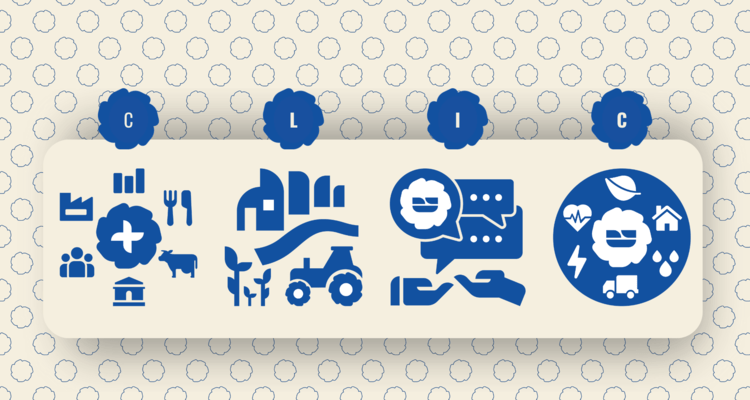
From theory to practice: explaining the CLIC
The FoodCLIC project is based on a solid theoretical foundation: the CLIC. With this guiding CLIC-framework at hand, the project consortium aims to support the creation and design of more sustainable urban food environments in Europe and - through its broadening process - also beyond.
Sustainable urban(-rural) food environments ensure that everyone has access to healthy and sustainably produced food, regardless of their socio-economic status. This can be achieved through systemic changes, through which the CLIC guides us.
The CLIC is an innovative framework that identifies a direction of travel for systemic innovation processes. The assumption behind it is that the overall goal of a sustainable food system transformation will only be achieved through the implementation of a mix of synergistic innovations that deliver, as far as possible, all four objectives (that can also be understood as properties of a system) described below.
- The generation (or strengthening) of Co-benefits between different sustainability objectives (social/ health, environmental and economic): Activities that realise benefits in one sustainability dimension can impact other parts of the food system (or other connected systems) in a positive or negative way, leading respectively to synergies (co-benefits) or trade-offs. Innovations that aim to increase the production of food in one particular region, for example, will only deliver co-benefits if, in addition to creating job opportunities for inhabitants, they will also enhance their social cohesion (through fair wages to workers and a more equitable distribution of food) and preserve the integrity of the natural environment.
- The (re-)establishment of reciprocal spatial, socio-cultural and environmental Linkages between urban and rural areas, and between land and sea: Innovations with potential for systemic food transformation do not prioritise the needs and interests of a community at the detriment of the needs and interests of other communities. Systemic innovations, by their very nature, break spatial fixes (i.e., the urban-rural divide); they create hybrid places where urban and rural actors exchange knowledge, resources, goods and services.
- The Inclusion of all food system actors in the innovation process, ensuring also a fairer distribution of its outcomes: Systemic innovations bypass the unequal power dynamics that exclude disadvantaged groups from the benefits of participation in sustainable development. Examples include the provision of technical and financial support to street food vendors to enhance access to fresh produce in disadvantaged areas, and the use of fresh fruit and vegetables from local community gardens to make meals for food bank users healthier. As a system-level property, inclusion raises the need for a robust multi-actor approach to the co-design and implementation of innovations.
- The establishment or strengthening of Connectivities between the food system and other sectors and policy priorities: Malnutrition, in all its different forms, is always indicative of underlying social, political, economic and environmental problems that need to be addressed holistically. Systemic innovations do so by connecting food with other policy goals (housing, transport, welfare, etc.) and by harmonising the (multi-scalar) governance context around them.
- Written by our guest author and consortium member, Professor Roberta Sonnino.
Download the CLIC Framework graphic here.
Publishing date:
FOODCLIC. We are connecting people, food, policy & places.
FoodCLIC is a four-year project funded by the EU. The project runs from September 2022 to February 2027. The acronym FoodCLIC stands for 'integrated urban FOOD policies – developing sustainability Co-benefits, spatial Linkages, social Inclusion and sectoral Connections to transform food systems in city-regions

